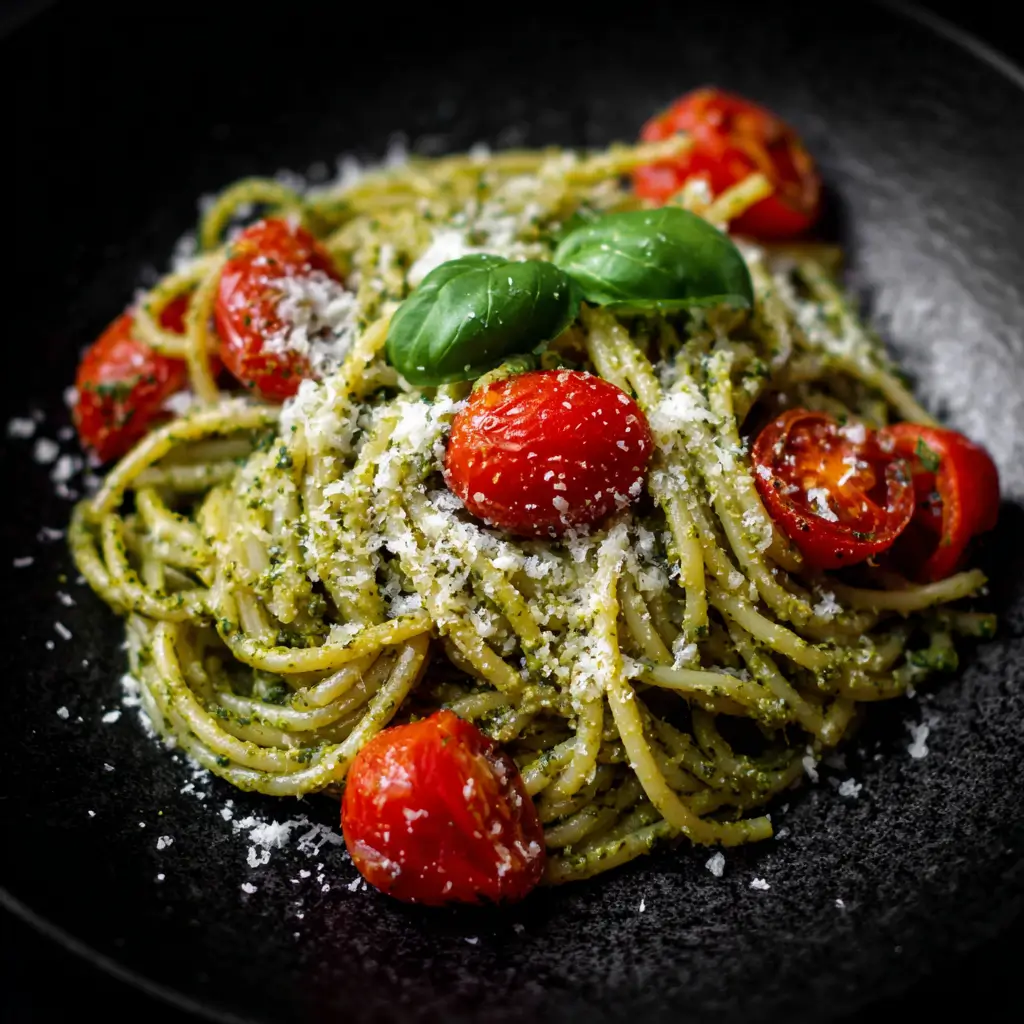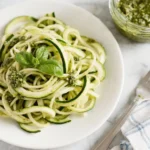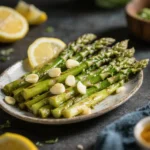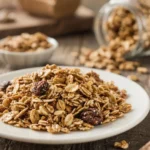Pesto Spaghetti with Cherry Tomatoes: A Fresh and Flavorful Italian Delight
The History
The origins of pesto spaghetti can be traced back to the sun-drenched region of Liguria in northwestern Italy, where the city of Genoa is considered the birthplace of traditional pesto alla genovese. This vibrant green sauce, made from fresh basil, pine nuts, garlic, Parmesan cheese, and extra-virgin olive oil, has been a staple in Italian cuisine since at least the 19th century. Originally prepared using a mortar and pestle, pesto was a way for coastal communities to preserve the essence of summer’s lush herbs through the cooler months. Over time, the dish evolved as Italian immigrants brought their culinary traditions abroad, adapting ingredients based on availability. The addition of cherry tomatoes to pesto spaghetti is a more modern innovation, reflecting contemporary tastes for bright acidity and color contrast. Cherry tomatoes, believed to have originated in South America and later cultivated in Europe, bring a sweet-tart juiciness that complements the richness of the pesto. Today, pesto spaghetti with cherry tomatoes is celebrated not only in Italy but across the globe as a quick, elegant, and wholesome meal that captures the spirit of Mediterranean cooking—simple ingredients transformed into something extraordinary.
Ingredients Breakdown
Creating an authentic yet modern version of pesto spaghetti with cherry tomatoes requires careful attention to ingredient quality and balance. Each component plays a crucial role in achieving the perfect harmony of flavors and textures:
- Spaghetti (or any long pasta): Traditionally, linguine or trenette are used in Ligurian pesto dishes, but spaghetti is widely favored for its ability to hold onto the thick, oily sauce. Opt for high-quality bronze-extruded pasta for a rougher surface that better captures the pesto.
- Fresh basil leaves: The star of the pesto, basil should be vibrant green, fragrant, and preferably organic. About 2 cups packed are needed for a standard batch. Avoid bruising the leaves before blending.
- Garlic: One clove adds pungency without overwhelming the delicate herbal notes. Some prefer it blanched or roasted for a milder flavor.
- Pine nuts: These provide a buttery richness and creamy texture. They can be lightly toasted to enhance their nuttiness, though this step is optional.
- Extra-virgin olive oil: Use a premium cold-pressed variety, as it forms the base of the sauce and contributes significantly to flavor. It should be fruity and slightly peppery.
- Parmesan cheese (Parmigiano-Reggiano): Aged and granular, this cheese adds umami depth. Grate it fresh for best results. Pecorino Romano can be substituted for a sharper taste.
- Cherry tomatoes: Choose ripe, plump tomatoes in a mix of colors—red, yellow, and orange—for visual appeal and nuanced sweetness. Halved or quartered, they burst with juice when warmed.
- Salt and freshly ground black pepper: Essential for seasoning both the pasta water and the final dish.
- Optional additions: Lemon zest for brightness, red pepper flakes for heat, or a splash of pasta cooking water to emulsify the sauce.
Step-by-Step Recipe
- Prepare the pesto sauce: In a food processor or blender, combine 2 cups of fresh basil leaves, 1/4 cup pine nuts, 1 peeled garlic clove, 1/2 cup grated Parmesan cheese, and a pinch of salt. Pulse until coarsely chopped. With the machine running, slowly drizzle in 1/2 cup of extra-virgin olive oil until the mixture becomes smooth and emulsified. Taste and adjust seasoning, adding more cheese, salt, or even a squeeze of lemon juice if desired. Set aside.
- Cook the spaghetti: Bring a large pot of salted water to a rolling boil—use about 1 tablespoon of salt per 4 quarts of water. Add 12 ounces of spaghetti and cook according to package instructions until al dente (usually 8–10 minutes). Stir occasionally to prevent sticking.
- Prepare the cherry tomatoes: While the pasta cooks, wash and halve 2 cups of cherry tomatoes. You can leave them raw for a crisp, fresh bite, or sauté them gently in a skillet with a little olive oil over medium heat for 3–5 minutes to release their juices and soften slightly. For enhanced flavor, add a minced garlic clove and a pinch of red pepper flakes during sautéing.
- Reserve pasta water: Before draining, scoop out about 1 cup of the starchy cooking water. This liquid gold helps bind the pesto to the pasta and creates a silky sauce consistency.
- Drain the pasta: Carefully drain the spaghetti, but do not rinse it—the starch on the surface is essential for helping the pesto adhere.
- Combine everything: Return the drained spaghetti to the warm pot. Add the prepared pesto and toss thoroughly using tongs or two forks. Gradually add 1/4 to 1/2 cup of reserved pasta water, stirring continuously until the sauce coats each strand evenly. The heat from the pasta will slightly wilt the basil and release the aromas of the garlic and cheese.
- Incorporate the cherry tomatoes: Gently fold in the cherry tomatoes, ensuring they are evenly distributed. If you’ve sautéed them, add them while still warm so their flavor melds into the dish.
- Final adjustments: Taste and season with additional salt, black pepper, or a sprinkle of red pepper flakes. For extra richness, stir in a tablespoon of butter or a drizzle of high-quality olive oil.
- Serve immediately: Plate the pesto spaghetti while hot, garnishing each serving with extra grated Parmesan, a few whole basil leaves, and a twist of lemon zest if desired.
Tips
- Use room temperature pesto: Cold pesto straight from the fridge can seize up when mixed with hot pasta. Let it sit at room temperature for 10–15 minutes before use.
- Don’t overcook the pasta: Al dente is key—overcooked spaghetti becomes mushy and won’t hold the sauce well.
- Emulsify the sauce properly: The combination of fat (olive oil), starch (pasta water), and agitation (tossing) creates a creamy, cohesive coating. Don’t skip the pasta water!
- Toast the pine nuts carefully: If toasting, do so in a dry pan over low heat, stirring constantly to avoid burning, which can make them bitter.
- Make pesto ahead: Pesto can be made a day in advance and stored in a jar with a thin layer of olive oil on top to prevent oxidation. Alternatively, freeze in ice cube trays for longer storage.
- Avoid metal bowls: When storing pesto, use glass or ceramic containers, as metal can react with the basil and cause discoloration.
- Add tomatoes just before serving: To maintain their freshness and color, incorporate cherry tomatoes at the very end, especially if using them raw.
- Balance the flavors: If the pesto tastes too oily, add more cheese or a squeeze of lemon. If too sharp, a teaspoon of honey or grated carrot can mellow it.
Variations and Customizations
Pesto spaghetti with cherry tomatoes is incredibly versatile and welcomes creative adaptations to suit dietary preferences or seasonal ingredients:
- Protein boost: Add grilled chicken, shrimp, salmon, or white beans for a heartier meal. Pan-seared tofu or tempeh works beautifully for plant-based diets.
- Vegetable additions: Toss in steamed broccoli, sautéed spinach, roasted zucchini, or artichoke hearts for added nutrition and texture.
- Different pesto bases: Try variations like sun-dried tomato pesto, kale and walnut pesto, arugula pesto, or cilantro-lime pesto for a non-traditional twist.
- Nut substitutions: Replace pine nuts with walnuts, almonds, cashews, or even sunflower seeds for a budget-friendly or allergen-conscious option.
- Dairy-free pesto: Omit Parmesan or use nutritional yeast to maintain the cheesy flavor without dairy. Many vegan pesto brands are also available.
- Gluten-free version: Use gluten-free spaghetti made from rice, corn, or legumes. Ensure all other ingredients are certified gluten-free if necessary.
- Herb swaps: Basil can be partially replaced with mint, parsley, or even tarragon for a unique aromatic profile.
- Creamy pesto: Blend in a tablespoon of ricotta, mascarpone, or Greek yogurt for a richer, creamier texture.
- Roasted cherry tomatoes: For deeper flavor, roast the tomatoes at 400°F (200°C) for 20–25 minutes with olive oil, salt, and thyme before mixing into the pasta.
- Seafood twist: Combine with clams, mussels, or scallops in a garlicky white wine broth for a luxurious seaside variation.
Health Considerations and Nutritional Value
Pesto spaghetti with cherry tomatoes is not only delicious but also offers several health benefits when prepared with mindful ingredient choices:
- Basil: Rich in antioxidants like flavonoids and vitamin K, basil has anti-inflammatory properties and supports bone health.
- Olive oil: A cornerstone of the Mediterranean diet, extra-virgin olive oil contains monounsaturated fats and polyphenols that support heart health and reduce inflammation.
- Pine nuts: High in protein, magnesium, zinc, and healthy fats, they contribute to satiety and metabolic function, though calorie-dense—portion control is advised.
- Cherry tomatoes: Packed with vitamin C, potassium, lycopene (a powerful antioxidant linked to reduced cancer risk), and fiber, they promote skin health and digestion.
- Parmesan cheese: Provides calcium, protein, and phosphorus, but is high in sodium and saturated fat—best enjoyed in moderation.
- Pasta: A source of carbohydrates for energy. Whole grain or legume-based pastas increase fiber and protein content, improving blood sugar regulation.
A typical serving (about 1.5 cups) of homemade pesto spaghetti with cherry tomatoes contains approximately:
- Calories: 450–550 kcal
- Fat: 20–28g (mostly unsaturated)
- Carbohydrates: 55–65g
- Protein: 12–16g
- Fiber: 4–6g
- Sodium: 400–700mg (varies with cheese and added salt)
To make the dish healthier:
- Reduce oil in pesto by substituting some with vegetable broth or white beans.
- Use whole wheat or chickpea spaghetti for added fiber and protein.
- Limited cheese quantity or opt for lower-fat versions.
- Increase the ratio of cherry tomatoes and greens to boost volume and micronutrients without adding calories.
Ingredients
- 12 oz (340g) spaghetti
- 2 cups fresh basil leaves, tightly packed
- 1/4 cup pine nuts (toasted or raw)
- 1 large garlic clove, peeled
- 1/2 cup freshly grated Parmesan cheese
- 1/2 cup extra-virgin olive oil
- 2 cups cherry tomatoes, halved
- 1 tbsp sea salt (for pasta water)
- Freshly ground black pepper, to taste
- Optional: 1/2 tsp red pepper flakes, 1 tsp lemon zest, 1/4 cup reserved pasta water
Directions
- In a food processor, blend basil, pine nuts, garlic, and Parmesan until finely chopped.
- With the motor running, slowly pour in olive oil until a smooth paste forms. Season with salt and set aside.
- Bring a large pot of salted water to a boil. Add spaghetti and cook until al dente. Reserve 1 cup of pasta water before draining.
- While pasta cooks, prepare cherry tomatoes—either leave them raw or sauté in olive oil with garlic and red pepper flakes for 3–5 minutes.
- Drain spaghetti and return to the pot.
- Add pesto and 1/4 cup of reserved pasta water. Toss vigorously over low heat for 1–2 minutes until glossy and well-coated.
- Gently fold in cherry tomatoes.
- Adjust consistency with more pasta water if needed. Season with pepper, extra cheese, or lemon zest.
- Serve immediately in warm bowls, garnished with additional Parmesan and fresh basil.
FAQ
- Can I make pesto in advance?
- Yes! Store pesto in an airtight container in the refrigerator for up to 5 days. Top with a thin layer of olive oil to prevent browning. For longer storage, freeze in ice cube trays and transfer to freezer bags.
- Why did my pesto turn brown?
- Browning occurs due to oxidation when basil is exposed to air. To minimize this, blanch basil briefly before blending, or store pesto with oil on top. Using a squeeze of lemon juice can also help preserve color.
- Can I use store-bought pesto?
- Absolutely. Choose high-quality, refrigerated pesto with minimal preservatives. Adjust seasoning and add fresh cherry tomatoes as directed.
- Is pesto spaghetti suitable for vegans?
- Traditional pesto contains cheese, but you can easily make a vegan version using nutritional yeast instead of Parmesan and ensuring no animal products are included.
- How do I reheat pesto spaghetti?
- Reheating can dull flavors and alter texture. Best enjoyed fresh. If needed, gently warm in a pan with a splash of water or broth to revive the sauce.
- Can I add meat to this dish?
- Yes. Grilled chicken, shrimp, or Italian sausage pair well. Cook separately and toss in at the end.
- What pasta shapes work best?
- Long pastas like spaghetti, linguine, or fettuccine work best. Short shapes like penne or fusilli also hold pesto well and are great for cold salads.
- Can I use dried basil?
- No—dried basil lacks the vibrancy and moisture needed for authentic pesto. Always use fresh basil for the best flavor and texture.
Summary
Pesto spaghetti with cherry tomatoes is a vibrant, flavorful dish that combines the creamy richness of homemade basil pesto with the juicy sweetness of fresh tomatoes for a meal that’s both satisfying and nutritious. Quick to prepare and endlessly customizable, it’s a modern classic that brings the taste of the Mediterranean to your table in under 30 minutes.










